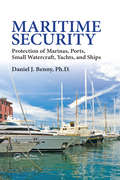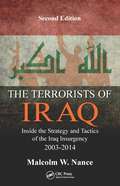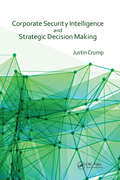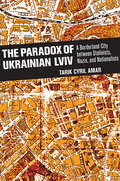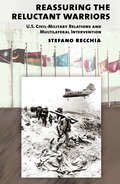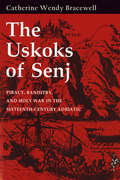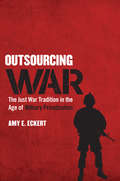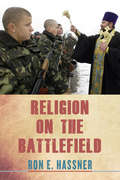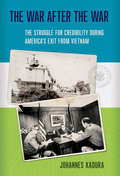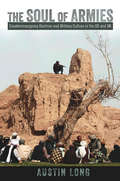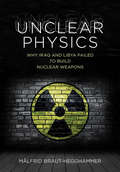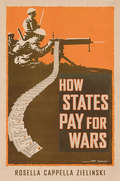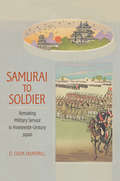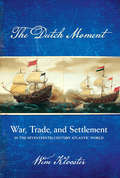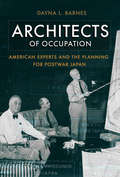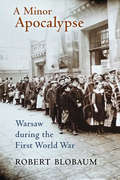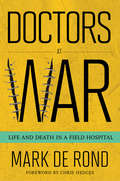- Table View
- List View
Maritime Security: Protection of Marinas, Ports, Small Watercraft, Yachts, and Ships
by Ph.D, Daniel BennyIn a time when threats against the maritime community have never been greater, Maritime Security: Protection of Marinas, Ports, Small Watercraft, Yachts, and Ships provides a single, comprehensive source of necessary information for understanding and preventing or reducing threats to the maritime community.The book defines what comprises the mariti
The Terrorists of Iraq: Inside the Strategy and Tactics of the Iraq Insurgency 2003-2014, Second Edition
by Malcolm W. NanceThe Terrorists of Iraq: Inside the Strategy and Tactics of the Iraq Insurgency 2003-2014, Second Edition is a highly detailed and exhaustive history and analysis of terror groups that both formed the Iraq insurgency and led to the rise of the Islamic State of Iraq and Syria (ISIS). It places heavy emphasis on the history, organization, and personal
Corporate Security Intelligence and Strategic Decision Making
by Justin CrumpDespite a clear and compelling need for an intelligence-led approach to security, operational, and reputational risks, the subject of corporate security intelligence remains poorly understood. An effective intelligence process can directly support and positively impact operational activity and associated decision-making and can even be used to driv
Maritime Security: Protection of Marinas, Ports, Small Watercraft, Yachts, and Ships
by Ph.D, Daniel BennyIn a time when threats against the maritime community have never been greater, Maritime Security: Protection of Marinas, Ports, Small Watercraft, Yachts, and Ships provides a single, comprehensive source of necessary information for understanding and preventing or reducing threats to the maritime community.The book defines what comprises the mariti
Disease in the Merchant Navy: A History of the Seamen's Hospital Society
by Gordon Cook Anna PavlovIn this unique, highly detailed examination, Gordon C Cook explores disease in the merchant navy through the history of the Seamen's Hospital Society. From its foundation in 1812, until the present day, the Seamen's Hospital Society has been responsible for the physical welfare of merchant seamen and has headed many remarkable advances in medical science. This handsome volume is ideal for all those with an interest in the Seamen's Hospital Society, medical and naval historians, and general readers with an interest in maritime and naval history.
A Foreigner’s Cinematic Dream of Japan: Representational Politics and Shadows of War in the Japanese-German Coproduction New Earth (1937)
by Iris HaukampIn early 1936, a German film team arrived in Japan to participate in a film coproduction, intended to show the 'real' Japan to the world and to launch Japanese films into international markets. The two directors, one Japanese and the other German, clashed over the authenticity of the represented Japan and eventually directed two versions, The Samurai's Daughter and New Earth, based on a common script. The resulting films hold a firm place in film history as an exercise in - or reaction against - politically motivated propaganda, respectively. A Foreigner's Cinematic Dream of Japan contests the resulting oversimplification into nationalised and politicised dichotomies. Drawing on a wide range of Japanese and German original sources, as well as a comparative analysis of the 'German-Japanese version' and the elusive 'Japanese-English version', Iris Haukamp reveals the complexities of this international co-production. This exclusive research sheds light not only on the films themselves, but also on the timeframe of its production, with both countries at the brink of war.
A Foreigner’s Cinematic Dream of Japan: Representational Politics and Shadows of War in the Japanese-German Coproduction New Earth (1937)
by Iris HaukampIn early 1936, a German film team arrived in Japan to participate in a film coproduction, intended to show the 'real' Japan to the world and to launch Japanese films into international markets. The two directors, one Japanese and the other German, clashed over the authenticity of the represented Japan and eventually directed two versions, The Samurai's Daughter and New Earth, based on a common script. The resulting films hold a firm place in film history as an exercise in - or reaction against - politically motivated propaganda, respectively. A Foreigner's Cinematic Dream of Japan contests the resulting oversimplification into nationalised and politicised dichotomies. Drawing on a wide range of Japanese and German original sources, as well as a comparative analysis of the 'German-Japanese version' and the elusive 'Japanese-English version', Iris Haukamp reveals the complexities of this international co-production. This exclusive research sheds light not only on the films themselves, but also on the timeframe of its production, with both countries at the brink of war.
Spaces of War, War of Spaces
Spaces of War, War of Spaces provides a rich, international and multi-disciplinary engagement with the convergence of war and media through the conceptual lens of 'space'. 'Space' offers a profound, challenging and original framework through which notions of communication, embodiment, enactment, memory and power are interrogated not only in terms of how media spaces (traditional, digital, cultural, aesthetic, embodied, mnemonic) transform the conduct, outcomes and consequences of war for all involved, but how 'war' actors (political, military, survivors, victims) recreate space in a manner that is transformative across political, social, cultural and personal spheres. Foregrounding the work of artists, activists and practitioners alongside more traditional scholarly approaches Spaces of War, War of Spaces engages with the 'messiness' of war and media through the convergence of practice and theory, where showing and embodying is made explicit.
Spaces of War, War of Spaces
by Laura Roselle Sarah Maltby Katy Parry Ben O’LoughlinSpaces of War, War of Spaces provides a rich, international and multi-disciplinary engagement with the convergence of war and media through the conceptual lens of 'space'. 'Space' offers a profound, challenging and original framework through which notions of communication, embodiment, enactment, memory and power are interrogated not only in terms of how media spaces (traditional, digital, cultural, aesthetic, embodied, mnemonic) transform the conduct, outcomes and consequences of war for all involved, but how 'war' actors (political, military, survivors, victims) recreate space in a manner that is transformative across political, social, cultural and personal spheres. Foregrounding the work of artists, activists and practitioners alongside more traditional scholarly approaches Spaces of War, War of Spaces engages with the 'messiness' of war and media through the convergence of practice and theory, where showing and embodying is made explicit.
Trench Coat (Object Lessons)
by Jane TynanObject Lessons is a series of short, beautifully designed books about the hidden lives of ordinary things.We think we know the trench coat, but where does it come from and where will it take us? From its origins in the trenches of WW1, this military outerwear came to project the inner-being of detectives, writers, reporters, rebels, artists and intellectuals. The coat outfitted imaginative leaps into the unknown. Trench Coat tells the story of seductive entanglements with technology, time, law, politics, trust and trespass. Readers follow the rise of a sartorial archetype through media, design, literature, cinema and fashion. Today, as a staple in stories of future life-worlds, the trench coat warns of disturbances to come.Object Lessons is published in partnership with an essay series in The Atlantic.
Trench Coat (Object Lessons)
by Jane TynanObject Lessons is a series of short, beautifully designed books about the hidden lives of ordinary things.We think we know the trench coat, but where does it come from and where will it take us? From its origins in the trenches of WW1, this military outerwear came to project the inner-being of detectives, writers, reporters, rebels, artists and intellectuals. The coat outfitted imaginative leaps into the unknown. Trench Coat tells the story of seductive entanglements with technology, time, law, politics, trust and trespass. Readers follow the rise of a sartorial archetype through media, design, literature, cinema and fashion. Today, as a staple in stories of future life-worlds, the trench coat warns of disturbances to come.Object Lessons is published in partnership with an essay series in The Atlantic.
The Paradox of Ukrainian Lviv: A Borderland City between Stalinists, Nazis, and Nationalists
by Tarik Cyril AmarThe Paradox of Ukrainian Lviv reveals the local and transnational forces behind the twentieth-century transformation of Lviv into a Soviet and Ukrainian urban center. Lviv's twentieth-century history was marked by violence, population changes, and fundamental transformation ethnically, linguistically, and in terms of its residents' self-perception. Against this background, Tarik Cyril Amar explains a striking paradox: Soviet rule, which came to Lviv in ruthless Stalinist shape and lasted for half a century, left behind the most Ukrainian version of the city in history. In reconstructing this dramatically profound change, Amar illuminates the historical background in present-day identities and tensions within Ukraine.
Reassuring the Reluctant Warriors: U.S. Civil-Military Relations and Multilateral Intervention (Cornell Studies in Security Affairs)
by Stefano RecchiaWhy did American leaders work hard to secure multilateral approval from the United Nations or NATO for military interventions in Haiti, Bosnia, and Kosovo, while making only limited efforts to gain such approval for the 2003 Iraq War? In Reassuring the Reluctant Warriors, Stefano Recchia draws on declassified documents and about one hundred interviews with civilian and military leaders to illuminate little-known aspects of U.S. decision making in the run-up to those interventions. American leaders, he argues, seek UN or NATO approval to facilitate sustained military and financial burden sharing and ensure domestic support. However, the most assertive, hawkish, and influential civilian leaders in Washington tend to downplay the costs of intervention, and when confronted with hesitant international partners they often want to bypass multilateral bodies. In these circumstances, America’s senior generals and admirals—as reluctant warriors who worry about Vietnam-style quagmires—can play an important restraining role, steering U.S. policy toward multilateralism.Senior military officers are well placed to debunk the civilian interventionists’ optimistic assumptions regarding the costs of war, thereby undermining broader governmental support for intervention. Recchia demonstrates that when the military expresses strong concerns about the stabilization burden, even hawkish civilian leaders can be expected to work hard to secure multilateral support through the UN or NATO—if only to reassure the reluctant warriors about long-term burden sharing. By contrast, when the military stays silent, as it did in the run-up to the 2003 Iraq War, the most hawkish civilians are empowered; consequently, the United States is more likely to bypass multilateral bodies and may end up shouldering a heavy stabilization burden largely by itself. Recchia’s argument that the military has the ability to contribute not only to a more prudent but also to a more multilateralist U.S. intervention policy may be counterintuitive, but the evidence is compelling.
The Uskoks of Senj: Piracy, Banditry, and Holy War in the Sixteenth-Century Adriatic
by Catherine Wendy BracewellIn this highly original and influential book, Catherine Wendy Bracewell reconstructs and analyzes the tumultuous history of the uskoks of Senj, the martial bands nominally under the control of the Habsburg Military Frontier in Croatia, who between the 1530s and the 1620s developed a community based on raiding the Ottoman hinterland, Venetian possessions in Dalmatia, and shipping on the Adriatic.Drawing on a broad range of sources, including the archives of the Dalmatian communes under Venetian rule and military frontier records, Bracewell provides the first comprehensive analysis of the uskoks as a social phenomenon, examining their origins, their military and social organization, their plunder economy, their mental world, and their relations with other groups in this borderland between three empires. The uskoks lived on the Christian-Muslim frontier, and they invoked Europe’s struggle against Islam to justify their often bloody deeds. As Bracewell demonstrates, however, their actions were also shaped by the maze of local political and economic rivalries, social conflicts, and confessional antagonisms. In a book that tests the concept of the social bandit, the author analyzes the motives that guided the uskoks and distinguishes these from the factors that impelled various elements of the local population to support them.
Outsourcing War: The Just War Tradition in the Age of Military Privatization
by Amy E. EckertRecent decades have seen an increasing reliance on private military contractors (PMCs) to provide logistical services, training, maintenance, and combat troops. In Outsourcing War, Amy E. Eckert examines the ethical implications involved in the widespread use of PMCs, and in particular questions whether they can fit within customary ways of understanding the ethical prosecution of warfare. Her concern is with the ius in bello (right conduct in war) strand of just war theory.Just war theorizing is generally built on the assumption that states, and states alone, wield a monopoly on the legitimate use of force. Who holds responsibility for the actions of PMCs? What ethical standards might they be required to observe? How might deviations from such standards be punished? The privatization of warfare poses significant challenges because of its reliance on a statist view of the world. Eckert argues that the tradition of just war theory—which predates the international system of states—can evolve to apply to this changing world order. With an eye toward the practical problems of military command, Eckert delves into particular cases where PMCs have played an active role in armed conflict and derives from those cases the modifications necessary to apply just principles to new agents in the landscape of war.
Religion on the Battlefield
by Ron E. HassnerHow does religion shape the modern battlefield? Ron E. Hassner proposes that religion acts as a force multiplier, both enabling and constraining military operations. This is true not only for religiously radicalized fighters but also for professional soldiers. In the last century, religion has influenced modern militaries in the timing of attacks, the selection of targets for assault, the zeal with which units execute their mission, and the ability of individual soldiers to face the challenge of war. Religious ideas have not provided the reasons why conventional militaries fight, but religious practices have influenced their ability to do so effectively. In Religion on the Battlefield, Hassner focuses on the everyday practice of religion in a military context: the prayers, rituals, fasts, and feasts of the religious practitioners who make up the bulk of the adversaries, bystanders, and observers during armed conflicts. To show that religious practices have influenced battlefield decision making, Hassner draws most of his examples from major wars involving Western militaries. They include British soldiers in the trenches of World War I, U.S. pilots in World War II, and U.S. Marines in Iraq and Afghanistan. Hassner shows that even modern, rational, and bureaucratized military organizations have taken—and must take—religious practice into account in the conduct of war.
The War after the War: The Struggle for Credibility during America's Exit from Vietnam
by Johannes KaduraIn The War after the War, Johannes Kadura offers a fresh interpretation of American strategy in the wake of the cease-fire that began in Vietnam on January 28, 1973. The U.S. exit from Vietnam continues to be important in discussions of present-day U.S. foreign policy, so it is crucial that it be interpreted correctly. In challenging the prevailing version of the history of the events, Kadura provides interesting correctives to the different accounts, including the ones of the key actors themselves, President Richard Nixon and Secretary of State Henry Kissinger foremost among them. In so doing, Kadura aims to forge a synthesis between orthodox and revisionist interpretations of this important period. Kadura finds that the strategy employed by Nixon and Kissinger centered on the concepts of "equilibrium strategy" and "insurance policy." That approach allowed them to follow a twofold strategy of making a major effort to uphold South Vietnam while at the same time maintaining a fallback strategy of downplaying the overall significance of Vietnam. Whether they won or lost on their primary bet to secure South Vietnam, Nixon and Kissinger expected to come through the crisis in a viable strategic position.
The Soul of Armies: Counterinsurgency Doctrine and Military Culture in the US and UK (Cornell Studies in Security Affairs)
by Austin LongFor both the United States and United Kingdom counterinsurgency was a serious component of security policy during the Cold War and, along with counterterrorism, has been the greatest security challenge after September 11, 2001. In The Soul of Armies, Austin Long compares and contrasts counterinsurgency operations during the Cold War and in recent years by three organizations: the US Army, the US Marine Corps, and the British Army. Long argues that the formative experiences of these three organizations as they professionalized in the nineteenth century has produced distinctive organizational cultures that shape operations. Combining archival research on counterinsurgency campaigns in Vietnam and Kenya with the author’s personal experience as a civilian advisor to the military in Iraq and Afghanistan, The Soul of Armies demonstrates that the US Army has persistently conducted counterinsurgency operations in a very different way from either the US Marine Corps or the British Army. These differences in conduct have serious consequences, affecting the likelihood of success, the potential for civilian casualties and collateral damage, and the ability to effectively support host nation governments. Long concludes counterinsurgency operations are at best only a partial explanation for success or failure.
Unclear Physics: Why Iraq and Libya Failed to Build Nuclear Weapons (Cornell Studies in Security Affairs)
by Målfrid Braut-HegghammerMany authoritarian leaders want nuclear weapons, but few manage to acquire them. Autocrats seeking nuclear weapons fail in different ways and to varying degrees—Iraq almost managed it; Libya did not come close. In Unclear Physics, Målfrid Braut-Hegghammer compares the two failed nuclear weapons programs, showing that state capacity played a crucial role in the trajectory and outcomes of both projects. Braut-Hegghammer draws on a rich set of new primary sources, collected during years of research in archives, fieldwork across the Middle East, and interviews with scientists and decision makers from both states. She gained access to documents and individuals that no other researcher has been able to consult. Her book tells the story of the Iraqi and Libyan programs from their origins in the late 1950s and 1960s until their dismantling.This book reveals contemporary perspectives from scientists and regime officials on the opportunities and challenges facing each project. Many of the findings challenge the conventional wisdom about clandestine weapons programs in closed authoritarian states and their prospects of success or failure. Braut-Hegghammer suggests that scholars and analysts ought to pay closer attention to how state capacity affects nuclear weapons programs in other authoritarian regimes, both in terms of questioning the actual control these leaders have over their nuclear weapons programs and the capability of their scientists to solve complex technical challenges.
How States Pay for Wars
by Rosella Cappella ZielinskiArmies fight battles, states fight wars. To focus solely on armies is to neglect the broader story of victory and defeat. Military power stems from an economic base, and without wealth, soldiers cannot be paid, weapons cannot be procured, and food cannot be bought. War finance is among the most consequential decisions any state makes: how a state finances a war affects not only its success on the battlefield but also its economic stability and its leadership tenure. In How States Pay for Wars, Rosella Cappella Zielinski clarifies several critical dynamics lying at the nexus of financial and military policy.Cappella Zielinski has built a custom database on war funding over the past two centuries, and she combines those data with qualitative analyses of Truman’s financing of the Korean War, Johnson’s financing of the Vietnam War, British financing of World War II and the Crimean War, and Russian and Japanese financing of the Russo-Japanese War. She argues that leaders who attempt to maximize their power at home, and state power abroad, are in a constant balancing act as they try to win wars while remaining in office. As a result of political risks, they prefer war finance policies that meet the needs of the war effort within the constraints of the capacity of the state.
Samurai to Soldier: Remaking Military Service in Nineteenth-Century Japan (Studies of the Weatherhead East Asian Institute, Columbia University)
by D. Colin JaundrillIn Samurai to Soldier, D. Colin Jaundrill rewrites the military history of nineteenth-century Japan. In fifty years spanning the collapse of the Tokugawa shogunate and the rise of the Meiji nation-state, conscripts supplanted warriors as Japan’s principal arms-bearers. The most common version of this story suggests that the Meiji institution of compulsory military service was the foundation of Japan’s efforts to save itself from the imperial ambitions of the West and set the country on the path to great power status. Jaundrill argues, to the contrary, that the conscript army of the Meiji period was the culmination—and not the beginning—of a long process of experimentation with military organization and technology. Jaundrill traces the radical changes to Japanese military institutions, as well as the on-field consequences of military reforms in his accounts of the Boshin War (1868–1869) and the Satsuma Rebellions of 1877. He shows how pre-1868 developments laid the foundations for the army that would secure Japan’s Asian empire.
The Dutch Moment: War, Trade, and Settlement in the Seventeenth-Century Atlantic World
by Wim KloosterIn The Dutch Moment, Wim Klooster shows how the Dutch built and eventually lost an Atlantic empire that stretched from the homeland in the United Provinces to the Hudson River and from Brazil and the Caribbean to the African Gold Coast. The fleets and armies that fought for the Dutch in the decades-long war against Spain included numerous foreigners, largely drawn from countries in northwestern Europe. Likewise, many settlers of Dutch colonies were born in other parts of Europe or the New World. The Dutch would not have been able to achieve military victories without the native alliances they carefully cultivated. Indeed, the Dutch Atlantic was quintessentially interimperial, multinational, and multiracial. At the same time, it was an empire entirely designed to benefit the United Provinces. The pivotal colony in the Dutch Atlantic was Brazil, half of which was conquered by the Dutch West India Company. Its brief lifespan notwithstanding, Dutch Brazil (1630–1654) had a lasting impact on the Atlantic world. The scope of Dutch warfare in Brazil is hard to overestimate—this was the largest interimperial conflict of the seventeenth-century Atlantic. Brazil launched the Dutch into the transatlantic slave trade, a business they soon dominated. At the same time, Dutch Brazil paved the way for a Jewish life in freedom in the Americas after the first American synagogues opened their doors in Recife. In the end, the entire colony eventually reverted to Portuguese rule, in part because Dutch soldiers, plagued by perennial poverty, famine, and misery, refused to take up arms. As they did elsewhere, the Dutch lost a crucial colony because of the empire’s systematic neglect of the very soldiers on whom its defenses rested.After the loss of Brazil and, ten years later, New Netherland, the Dutch scaled back their political ambitions in the Atlantic world. Their American colonies barely survived wars with England and France. As the imperial dimension waned, the interimperial dimension gained strength. Dutch commerce with residents of foreign empires thrived in a process of constant adaptation to foreign settlers’ needs and mercantilist obstacles.
Architects of Occupation: American Experts and Planning for Postwar Japan
by Dayna L. BarnesThe Allied occupation of Japan is remembered as the "good occupation." An American-led coalition successfully turned a militaristic enemy into a stable and democratic ally. Of course, the story was more complicated, but the occupation did forge one of the most enduring relationships in the postwar world. Recent events, from the occupations of Iraq and Afghanistan to protests over American bases in Japan to increasingly aggressive territorial disputes between Asian nations over islands in the Pacific, have brought attention back to the subject of the occupation of Japan.In Architects of Occupation, Dayna L. Barnes exposes the wartime origins of occupation policy and broader plans for postwar Japan. She considers the role of presidents, bureaucrats, think tanks, the media, and Congress in policymaking. Members of these elite groups came together in an informal policy network that shaped planning. Rather than relying solely on government reports and records to understand policymaking, Barnes also uses letters, memoirs, diaries, and manuscripts written by policymakers to trace the rise and spread of ideas across the policy network. The book contributes a new facet to the substantial literature on the occupation, serves as a case study in foreign policy analysis, and tells a surprising new story about World War II.
A Minor Apocalypse: Warsaw during the First World War
by Robert E. BlobaumIn A Minor Apocalypse, Robert Blobaum explores the social and cultural history of Warsaw's "forgotten war" of 1914–1918. Beginning with the bank panic that accompanied the outbreak of the Great War, Blobaum guides his readers through spy scares, bombardments, mass migratory movements, and the Russian evacuation of 1915. Industrial collapse marked only the opening phase of Warsaw’s wartime economic crisis, which grew steadily worse during the German occupation. Requisitioning and strict control of supplies entering the city resulted in scarcity amid growing corruption, rapidly declining living standards, and major public health emergencies. Blobaum shows how conflicts over distribution of and access to resources led to social divisions, a sharp deterioration in Polish-Jewish relations, and general distrust in public institutions. Women’s public visibility, demands for political representation, and perceived threats to the patriarchal order during the war years sustained one arena of cultural debate. New modes of popular entertainment, including cinema, cabaret, and variety shows, created another, particularly as they challenged elite notions of propriety. Blobaum presents these themes in comparative context, not only with other major European cities during the Great War but also with Warsaw under Nazi German occupation a generation later.
Doctors at War: Life and Death in a Field Hospital (The Culture and Politics of Health Care Work)
by Mark de RondDoctors at War is a candid account of a trauma surgical team based, for a tour of duty, at a field hospital in Helmand, Afghanistan. Mark de Rond tells of the highs and lows of surgical life in hard-hitting detail, bringing to life a morally ambiguous world in which good people face impossible choices and in which routines designed to normalize experience have the unintended effect of highlighting war’s absurdity. With stories that are at once comical and tragic, de Rond captures the surreal experience of being a doctor at war. He lifts the cover on a world rarely ever seen, let alone written about, and provides a poignant counterpoint to the archetypical, adrenaline-packed, macho tale of what it is like to go to war. Here the crude and visceral coexist with the tender and affectionate. The author tells of well-meaning soldiers at hospital reception, there to deliver a pair of legs in the belief that these can be reattached to their comrade, now in mid-surgery; of midsummer Christmas parties and pancake breakfasts and late-night sauna sessions; of interpersonal rivalries and banter; of caring too little or too much; of tenderness and compassion fatigue; of hell and redemption; of heroism and of playing God. While many good firsthand accounts of war by frontline soldiers exist, this is one of the first books ever to bring to life the experience of the surgical teams tasked with mending what war destroys.
